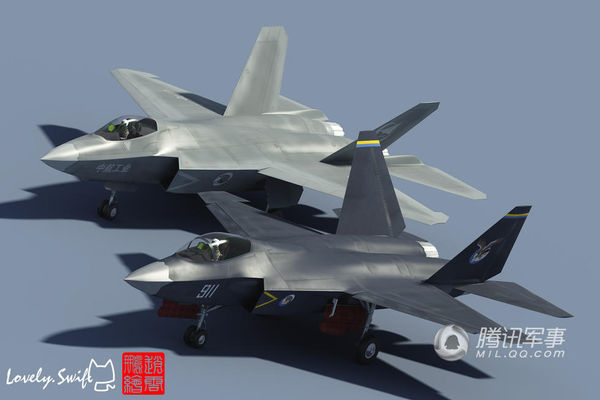


The new J-31 prototype (the one in lighter gray paint) is expected to be larger, have a nose-mounted infrared search and tracking sensor, and stealthy features like clipped horizontal and vertical stabilizers.
The improved J-31 stealth fighter prototype has been ramping up its test flights in April 2017, adding fuel to speculation that it will become the stealth fighter for Chinese aircraft carriers.

A New Bird
Lovely Swift at mil.qq.com
Back in October 2012, China became the second country in the world (after the United States) to have multiple fifth-generation stealth programs, as the first FC-31/J-31 stealth fighter (FC-31 is the export designation) made its maiden flight. Built by the Shenyang Aircraft Corporation (SAC), the twin-engine J-31 is roughly the same size as the American F-35, with a range of 775 miles, a maximum takeoff weight of 28 tons, and a Mach 1.8 top speed. If it enters Chinese service, it would replace single-engine J-10s as a medium fighter, and possibly become a stealth fighter on China's aircraft carriers.
Long Wait
The first prototype/tech demonstrator first flew in 2012. The second prototype's upgrades—stealthier wings, IRST sensor and a single piece canopy—first shown at the Zhuhai 2014 Airshow, but the aircraft had to wait until December 2016 to fly.
Blitzo at Sinodefence.com
Initially, there have been substantial doubts about the viability of the J-31 program. The first prototype did not fly with advanced avionics like an infrared search and track (IRST) sensor and stealth features like swept vertical stabilizers, suggesting its role to be a proof of concept for testing SAC's stealth technology, and hopefully attract buyers. More tellingly, while SAC pitched the J-31 as an export fifth generation fighter at domestic and international air shows, neither the PLAAF nor foreign buyers showed firm interest in the project, leaving its viability uncertain.
No Smoke
Unlike the first J031, "31001", which flew with smoky RD-93/WS-13 engines, the second prototype is flying with cleaner burning, likely more fuel-efficient engines.
A.Man at Sinodefence Forum
This uncertainty held until the second, improved prototype first flew on December 26, 2020. The new J-31 prototype is three tons heavier and about 20 inches longer than the original technology demonstrator; it also had key improvements like an IRST sensor, stealthier wings, cleaner burning engines, and an improved radar. In addition to avionics and datalinks that enable sensor fusion, SAC officials state that the production J-31s (which could appear soon as 2019) could have supercruise capability, giving them a leg up over current F-35 fighters. Its WS-13 engines would be replaced by domestic WS-13E or WS-17 turbofan engines to give it that advantage in speed. The combination of the J-31's high speed performance, and suggested payload of 6 PL-12 or 4 PL-21 long range air to air missiles suggests that the J-31 has been optimized as an air superiority fighter, though it can be fitted with a wide array of Chinese precision guided munitions like the LS smart bombs.
Gyrfalcon
The Shenyang "Gyrfalcon" J-31 stealth fighter, China's second stealth fighter program, is speculated to have a possible carrier-capable configuration, with folding wings and reinforced landing gear.
O+Nil
There's been talk on Chinese Internet messaging boards suggesting that SAC has recently won government funding for a J-31 carrier version, which could be larger than the initial prototypes (the carrier capable F-35C is also larger than the basic F-35A variant), in order to increase range, payload, and structural strength for the stress of carrier flight operations. SAC also plans to unveil a model of the third prototype of the J-31 at the 2017 Paris Air Show, possibly aimed at Middle Eastern buyers unable to purchase the politically sensitive F-35.

EDITOR'S PICKS











